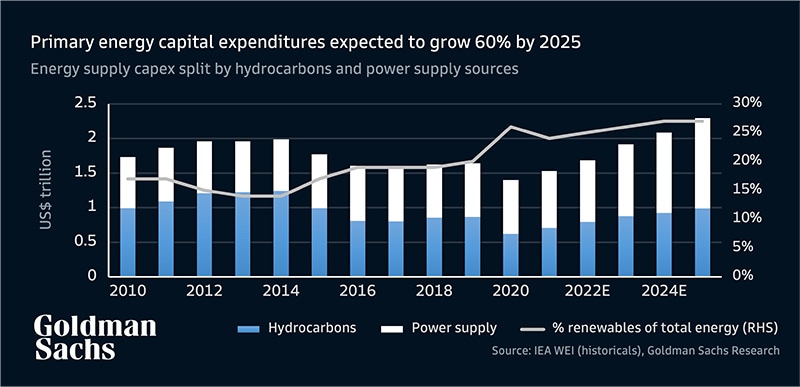How Ukraine Changes the Future of Energy Investing


After years of declining investment in fossil fuels, capital expenditures in the energy industry are set to climb as the war between Ukraine and Russia causes a global reset in how the world produces energy. “We believe that the recent focus on energy security, resilience and diversification will drive a new era for energy investments,” according to the Carbonomics team in Goldman Sachs Research.
Investment in the production of hydrocarbon, nuclear and renewable power is forecast to rise 60% to $1.4 trillion in the next three years, according to Goldman Sachs Research, having dropped 35% during the past decade. U.S. shale and offshore oil projects are likely to see increased funding, but the drive for decarbonization will endure, driving investment in liquefied natural gas, renewables, bio-energy and hydrogen to new highs. To meet the world’s rising energy needs, capital expenditures are expected to rise to about $2 trillion annually by 2024.


While much attention has shifted to clean energy — renewable investment exceeded upstream oil and gas spending for the first time in 2020 — capital expenditures in that sector haven’t made up for the drop in spending in the traditional energy industry. Goldman Sachs Research expects renewables and bio-energy’s share of total energy supply investing to rise in the coming years. But investment will still be necessary in other parts of the ecosystem such as natural gas, which is needed as a transition fuel and for resilience, and in power networks throughout the decade. Investment in clean hydrogen will be needed for the longer-term.
To have a future built on sustainable energy, a major acceleration is needed in clean-energy investment: these low-carbon technologies require two-times or more of the capital expenditures per unit of energy of the hydrocarbons they are meant to replace. Goldman Sachs’ Carbonomics research estimates that $56 trillion of investment in clean tech infrastructure by 2050 ($2 trillion annually) is needed to reach net-zero carbon emissions by that year.
Our signature newsletter with insights and analysis from across the firm
By submitting this information, you agree that the information you are providing is subject to Goldman Sachs’ privacy policy and Terms of Use. You consent to receive our newletter via email.